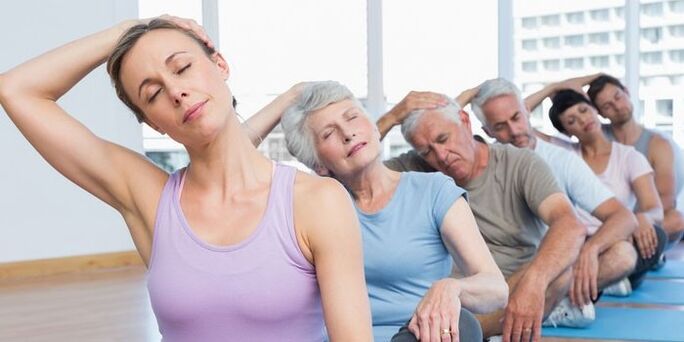Sedentary work, spinal injuries, obesity - there are many reasons why osteochondrosis (dystrophic diseases of the intervertebral discs) develops. Over the years, pathological changes develop, which are gradually manifested by numbness in the hands, burning between the shoulder blades, neck pain and other unpleasant symptoms. You can help yourself if you start exercising on time.
The benefits of exercise therapy for osteochondrosis of the cervical spine
Not so long ago, osteochondrosis of the cervical spine was considered an age-related disease, but today the disease has become much younger and can occur even in patients aged 20-30 years. It is impossible to completely get rid of dystrophic disorders, but well-chosen treatment significantly improves the patient's quality of life. One of the leading places in the treatment of osteochondrosis is the therapeutic and physical culture complex (LFK). Simple training has many advantages:
- They help strengthen the muscular corset, increase muscle tone and elasticity of the ligaments, thereby significantly reducing the load on the spine.
- Regular exercises relieve pain in the neck, headaches, burning between the shoulder blades.
- Gymnastics with cervical osteochondrosis activates blood circulation, reduces the likelihood of a stroke and increases the supply of oxygen to the brain.
- Courses in the early stages allow you to stop the progression of the dystrophic process and improve posture.
Indications and contraindications
Supercharging with osteochondrosis is prescribed during the period of remission, when the pain subsides. It helps relieve exacerbations, prevents the development of repeated attacks of pain, complications and further destruction of the joints. Patients with minor spinal injuries, diabetes mellitus, arterial hypertension should perform the prescribed exercises in a light version and initially only under the supervision of a doctor or trainer.
You should not start exercising immediately after eating, on an empty stomach, or after severe physical exertion. Physiotherapeutic exercises are also contraindicated in the following pathological conditions:
- arterial hypertension;
- arrhythmia, tachycardia;
- glaucoma, severe myopia;
- Diseases of the vestibular apparatus associated with impaired coordination;
- infectious lesion of the spine;
- time of exacerbation of osteochondrosis;
- aortic aneurysm;
- condition after the heart attack in the stage of early rehabilitation;
- severe spinal injuries;
- acute viral diseases of the respiratory tract.

Execution Rules
Before starting gymnastics with cervical osteochondrosis, you should familiarize yourself with the general rules of physical education:
- Exercise must be done in a well-ventilated area.
- Clothing for training should be loose, not restricting movement and not causing discomfort.
- Before class, you should measure your pulse and pressure, in case of an increase, refuse to perform exercises.
- To reduce the risk of injury, all movements should be performed smoothly, gradually increasing the load, intensity and number of repetitions, maintaining posture.
- Gymnastics with cervical osteochondrosis should be performed regularly. Many exercises are suitable for carrying out at work or during your studies.
- If you feel severe pain, dizziness or nausea during exercise therapy, immediately stop further exercise and sit down to rest. In the future, reduce the load and consult a doctor.
- In addition to exercises, therapeutic massage courses and physiotherapy can be prescribed.
Exercises for cervical osteochondrosis at home
In therapeutic gymnastics, simple exercises are performed. With the permission of the doctor, they can be performed at home with relaxing music. The main condition is that the spine should be as straight as possible, so it is better not to lie down, but to practice standing or sitting in a chair without a backrest. Exercise at the same time every day for a lasting therapeutic effect.
What is a warm-up for?
An important part of any physical activity is muscle preparation. A light warm-up will help prevent injury, warm up muscles, prepare the body for the start of intense training, improve circulation, and stretch. Sample set of exercises:
- Sit in a straight-backed chair, relax, and lower your arms along your torso. Make circular movements with your shoulders, first forward, then back. Do 5-10 reps on each side.
- Staying in the same position, spread your arms parallel to the floor. As you inhale, bend your elbows and gently touch your shoulders with your fingertips. Return to the starting position on an exhale. Perform 10 overtimes.
- Standing upright, place your palms on your shoulders, elbows parallel to the floor. Start at one or two with alternating circular motions with your elbows. First, with your right hand, connect the end of the circle and connect your left elbow. Make 5 circles for each hand.
- Assume the starting position as in the first exercise. Tighten your arms, begin to rock your shoulders back and forth. Repeat the process 10 times for each side.
Isometric exercises for the neck with osteochondrosis
With this complex, all exercises are performed without moving the head or neck - only with the help of muscle tension. Isometric gymnastics in cervical osteochondrosis is considered the safest, so it is prescribed to patients to relieve pain during an exacerbation of the disease. All exercises are performed from one position: standing or sitting in a chair without a backrest. The duration of a task is 5 seconds, the number of approaches 2-5. Examples of effective exercises:
- Clasp your fingers together and place your palms on your forehead. Begin to press your hands to your forehead as if trying to tilt your head, resisting with your neck muscles to keep the body motionless.
- Move your hands towards the back of your head in the same position. Press with your palms, make a micro-movement of the head forward. At the same time, resist the arms using the muscles of the neck and forearm.
- Place your right hand, palm on your cheek. Press your hand to your face and try tilting your head to the left. At the same time, tighten your muscles and do not let your head bend. Do the same exercise with your left hand.
- Stand up, spread your feet shoulder-width apart. Hands to the side, palms outward. Tighten the muscles in your neck, arms and back. Squeeze your elbows together and then back, trying to get your hands behind your back as much as possible. Bringing and spreading the elbows is done carefully without relaxing the muscles and maintaining balance.
Dynamic gymnastics
Physical education classes in cervical osteochondrosis must necessarily include exercises aimed at strengthening and increasing muscle tone of the upper limbs, neck, shoulder girdle and lower back. That's what dynamic assignments are for. All are performed at a fast pace, with a 10-15 second break between sets. You should know that dynamic gymnastics is contraindicated in exacerbations of osteochondrosis, diabetes, spinal injuries, cardiovascular diseases.
Approximate set of exercises:
- Stand up straight, bring your legs together, place your hands on your waist. Tilt your head gently and try to reach your shoulder with your ear. Do 5-6 repetitions for each side.
- While sitting or standing, slowly raise your hands and bring your palms together. As you exhale, slowly return to the starting position. Do 10-15 repetitions.
- Stand up, spread your feet apart, lower your arms along your torso. At the same time, without raising your arms, do circular twists with your shoulders. Perform 15 circular movements in 3 sets. To make it more difficult, you can alternately make circles - first with the left, then with the right shoulder.
- While standing, pull your right hand backwards and at the same time lift your left hand upwards. Do 10 reps and 3 sets for each limb.
- Standing, lower your arms along your torso. Make alternating stroking movements that slide up the sides, raising your shoulders as much as possible. Perform the task for 1 minute, then take a break and 2 more sets.

A set of exercises for osteochondrosis of the cervical spine
Numerous patients of a rehabilitation doctor successfully got rid of hypertension, osteochondrosis and other health problems with the help of neck exercises. The doctor claims that his physical education classes help to improve blood circulation, develop the muscles of the neck and upper spine, and prevent the development of heart attacks and strokes. Gymnastics for cervical osteochondrosis will be useful during the rehabilitation period after surgical interventions or injuries and for people with the following pathologies:
- Hypertension;
- drowsiness or insomnia;
- chronic migraine;
- deterioration of memory.
The author of the technique recommends performing all exercises while seated. It is important to keep your back as straight as possible and not to rush, otherwise you will not only not get positive results, but also worsen your condition. To monitor your posture, conduct the program in front of a mirror at the initial stage. The training scheme is as follows: the first two weeks - every day, then 3-4 training sessions per week.
Therapeutic exercises for osteochondrosis of the cervical spine have certain contraindications. Gymnastics cannot be done with:
- increased body temperature, general malaise, weakness;
- exacerbation of osteochondrosis;
- oncological diseases;
- Disc prolapse;
- during pregnancy;
- infectious and viral diseases;
- Risk of internal bleeding.
7 exercises for neck and shoulders
The complex consists of seven tasks that must be performed while sitting on a chair without a backrest or other hard surface. All exercises for the treatment of cervical osteochondrosis are presented in the table below:
| Exercise name | starting position | basics | number of repetitions |
|---|---|---|---|
| spring | Sitting in front of a mirror, arms down by your side, head straight. | Tuck your chin back as far as possible. Hold for 20 seconds, then gently pull your chin forward and up. After 20 seconds, return to the starting position. | five |
| metronome | Sitting in front of a mirror, arms down by your side, head straight. | Lower your head to the right side as far as possible. Lock the position for 10 seconds. Slowly return to the starting position and repeat the same for the other side. | five |
| A look at the sky | The same | Keep your head straight, chin parallel to the floor. Gently turn your head to the right and hold the position for 10 seconds. Return to the beginning and repeat the same for the other side. | five |
| goose | Sitting, arms by your side, chin tucked forward. | From the starting position, gently rotate your head to the right and down, trying to reach your shoulder with your chin. Freeze for 10 seconds, then repeat the task for the other side. | 6 |
| frame | Seated, right palm on left shoulder, elbows parallel to floor. | Reach the shoulder of your right hand with your chin. Hold the position for a few seconds. Gently return to start. Repeat the same for the left side. | five |
| fakir | Hands overhead with palms together. | Twist your neck to the left and keep your chin straight. Freeze 10 seconds, return to start. Repeat the exercise for the left side. | 7 |
| heron | Sit in a chair with your back straight. | Straighten your arms, palms to the floor. Pull them back while tucking your chin forward. Hold the body position for 20 seconds. | 4 |
Therapeutic effects and results
Therapeutic exercises for osteochondrosis of the cervical spine will help to improve the course of the disease in a short time and, with constant performance, will help to cure osteochondrosis without taking any medication. It is not at all necessary to immediately perform the whole wellness complex of the proposed exercises, beginners can easily choose those that are given to them, gradually increasing the volume. After achieving therapeutic effects, you should not stop exercising, improving the condition must be constantly maintained.
If there are no strict contraindications, you can stretch the spine on the horizontal bar. Such an exercise will help put the intervertebral discs in place, give strength, strengthen the muscular corset. Suitable for swimming, dancing, light fitness, yoga or aerobics. To prevent osteochondrosis and fully recover, doctors recommend maintaining an active lifestyle and properly organizing the workplace.


























